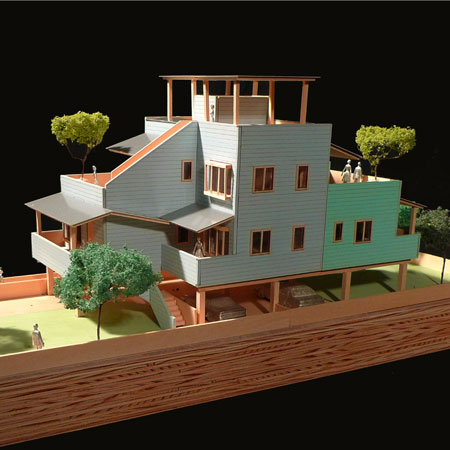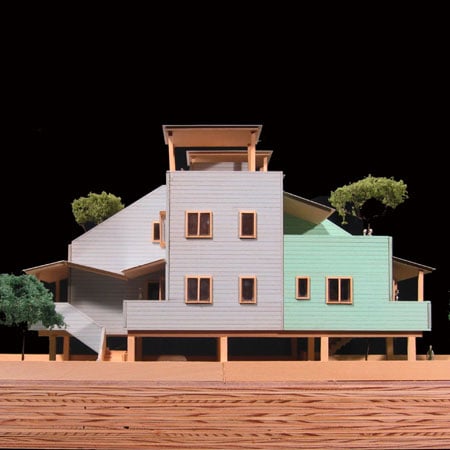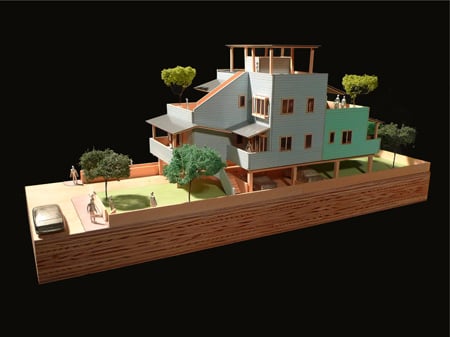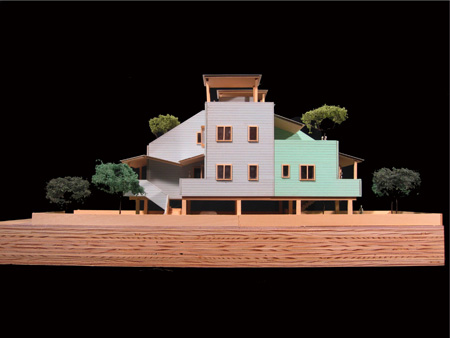
Duplex by Frank Gehry for Make it Right
Frank Gehry is one of 14 architects to have designed duplexes for Make it Right, the charity founded by actor Brad Pitt to develop new housing typologies for a hurricane-devastated district of New Orleans.

The new designs, unveiled yesterday, are for multi-family dwellings and follow the range of single-family homes unveiled in January last year.

Local and international architects have designed housing for the project, with Elemental, Pugh + Scarpa, MVRDV and GRAFT among those whose designers were unveiled yesterday.

See our earlier story for more information about Make it Right. Here's some info about the new designs followed by a statement about Gehry's project:
--
Make It Right Architects Break New Green Ground with Duplex Designs
Families from the Lower 9th Ward can now choose to build a duplex in the Make It Right neighborhood. Until now, only single family homes were available and being built on the site devastated by Hurricane Katrina. Fourteen acclaimed local, national and international architects volunteered their time, met with the community and potential homeowners and applied their experience and creativity to come up with high quality designs that push the envelope.
The Designs
While each of the 14 duplex designs is unique, the architects tackled some common problems and arrived at innovative solutions that could change the way multi-family homes are built:
Flexibility – A number of the designs feature interchangeable floor plans that allow the families to change the size and configuration of the two homes as their family size, needs or economic situation changes.
Integration with the Street – Increasing the elevation of the homes made them safer from flooding, but interrupted the connectedness between the porch and life on the street –a relationship valued by the Lower 9th Ward community. To solve this problem, several architects created midpoint landings or stoops in the stairways where the family could gather.
Landscaping as a design and energy element – Several architects incorporated landscaping into their design of these solar-powered, highly energy efficient homes to maximize exposure to sun and shade and cut heating and cooling costs. And because outdoor living is such a core part of life in the Lower 9th Ward, many of the designs include courtyards, interior gardens, and social use of the area under the elevated house.
Affordability — To cut the cost, but not the quality of these duplexes, several of the architects, stacked the houses one on top of the other to reduce the “footprint” of the home and simplify construction.
Duplex Designs
Genhry Partners, LLP / Los Angeles, CA
About the Architect
Our design for the MIR Two-family home began with the initial community feedback meeting and a study of the local typologies and proposed program. Of the components of local vernacular, the majority of the community expressed a desire for quality outdoor space, especially the garden.
Starting with this initial desire, two story solutions were explored to reduce the overall footprint of the built structure, which would maximize available garden area, and potentially reduce foundation costs. Several basic diagrams for program organization were studied falling into two basic categories – side by side and front to back. The front to back organization allowed for better flow of the interior spaces, and a better proportioned single garden for each house. The front to back organization maximizes privacy for each house, as the area/length of common wall is reduced.
The two-story front to back diagram led to additional outdoor amenities that could be provided, including porches, canopies, a second floor terrace, and a roof top shoo-fly for each house. The finish floor of the first level was raised to 9’ above grade to allow the area below the first floor to be useable for parking and storage areas for each house. The use of a central stairway to the second floor creates a natural solar chimney, increasing passive ventilation efficiency for each house. Rooftop solar panels, rain water collection from the terraces, sun shading, cross ventilation, and geothermal cooling are additional sustainable strategies that have been incorporated into the design.
Each house maintains an entry on the street frontage on opposite sides of the lot. The front house is entered through the front garden with a stair case conveniently located adjacent to the parking. A partially covered staircase leads to the front porch, which overlooks the garden. One enters the house into the central great room, using an open plan for living, dining, and kitchen to maximize efficiency of floor area. The living area has a bay window to the front porch. The kitchen has a central island, providing separation of the kitchen area without a wall. A short corridor off of the living room leads to the first floor bedroom and bathroom, laundry area, and coat closet. The first floor bedroom has a private canopied porch, and a corner bay window.
An open stairway leads to the second floor bedroom and bathroom. The second floor bedroom has a corner bay window. At the top landing, two opposing windows allow for cross ventilation, increasing the efficiency of the solar chimney. A door provides access to the second floor terrace, which overlooks the garden. An exterior stair stacked on top of the interior stair provides access to the roof top shoo-fly, providing great views. Solar panels are placed above the shoo-fly to double as a shading device for the rooftop terrace. The rear house is accessed via a path in the side yard to a staircase adjacent to the rear garden and to parking for the rear house. The sequence of rooms for the rear house is identical to the front house.
The plan for each house is identical, rotated 180 degrees, allowing for construction efficiency. Bathrooms on both levels are stacked, bedrooms are stacked, staircases are stacked, and the great room concept for living, dining, and kitchen have all been employed to gain construction efficiency.
The final visual appearance of the two-family home is a simple expression of the solution to the design goals and parameters.